| 1946 |
 Chronomedia index Chronomedia index
Numbers after entries link to the list of references. |
links and notes |
| |
Cultural highlights | Predictions made this year |
|
| January 3 |
William Joyce, the Nazi broadcaster Lord Haw-Haw, is hanged for treason in London. Joyce was born in the US to Irish parents but had held a British passport since 1933. His was the last execution for treason in the UK. He was the only broadcaster to be executed for wartime activities, although others received prison sentences. |
|
| January 17 |
Opening session of the United Nations Security Council is televised in New York. |
|
| February 1 |
University of Pennsylvania holds a press conference to announce development of ENIAC (Electronic Numerical Integrator And Calculator). Although proclaimed as the world's first electronic computer, that honour belongs to the British computer Colossus, which was an ultra-secret project at the time. |
|
| February 4 |
CBS has demonstrated television transmission of colour film from a new UHF transmitter, according to a report in trade paper Broadcasting. Receivers could be on the consumer market within a year. |
|
| February 11 |
Trial recording of audience participation quiz programme Have a Go, compered by Wilfred Pickles and supported by his wife Mabel ('What's on the table, Mabel?', referring to the small prizes on offer), is made by the BBC Northern Region in Bradford, Yorkshire. The first edition to be broadcast is recorded on February 16 at Bingley, Yorkshire. |
|
| February 15 |
ENIAC computer is formally accepted from the University of Pennsylvania by the US Army Ordnance Corps. Its principal use is to be in ballistics calculations. |
|
| February 18 |
Television signals are successfully transmitted from Washington to New York via AT&T coaxial cable. |
|
| March 7 |
In the US, the Federal Communication Commission publishes Public Service Responsibilities for Broadcast Licensees (the Blue Book), a 139-page report described by Justin Miller, president of the National Association of Broadcasters as an invasion of freedom of speech. |
|
| March 21 |
First post-war monochrome filmed television recordings are made at the US Naval Air Station at Anacostia, DC, as part of a demonstration of airborne television. |
|
| March 24 |
BBC begins broadcasts in Russian. Winston Churchill made his 'Sinews of Power' speech at Fulton, Missouriin which he coined the phrase 'iron curtain' in anticipation of the coming Cold Waron 5 March. |
|
| March 25 |
United States Network, with a capital of $1m in one-dollar shares, is registered in Delaware. The attempt at creating a new radio network by linking local stations fails. |
|
| March |
UK's Rank Organisation buys a half share in Greater Union, the Australian film distribution/exhibition company. |
|
| April 1 |
ABC television network adopts a policy of using recordings and delayed transmissions to schedule programmes at the same time across all US time zones. |
|
| April 22 |
CBS transmits colour television signals by coaxial landline from New York to Washington and back. |
|
| April |
Pinewood Studios re-opens after being used for various purposes during the war. |
|
| April |
British Lion pays £380,000 for a 74 per cent stake in Sound City Film and its Shepperton Studios. The facility is renamed British Lion Studio Company. British Lion also acquires Worton Hall Studios (1944) Ltd and consequently lets its Beaconsfield Studios on a 21-year lease to the British government. [0019] |
|
| May 9 |
NBC broadcasts the first one-hour US television variety show, Hourglass. |
|
| May 27 |
Tests of the Westinghouse/Glenn L Martin Stratovision airborne system for television relay are conducted on the US east coast and between Boston and Detroit. |
|
| June 1 |
Combined television and radio receiving licence is introduced in the UK at £2, a surcharge of £1 for the addition of television. |
> July
Radio licence fee
TV licence fee |
| June 7 15:00 |
BBC Television Service re-opens from Studios A and B at Alexandra Palace with the same cartoon that had been interrupted on 1 September 1939. Viewing hours are 20:30 to 22:00 daily. The studio has a Mechau telecine unit. The budget for the service is fixed below the level of 1939. The number of staff at Alexandra Palace is 456. |
> 1948 |
| June 8 |
Allies Victory Parade through London is televised by the BBC. The cinema newsreel is only the second ever shot in Technicolor. |
|
| June 10 |
Baird demonstrates large-screen television at the Classic Cinema, Baker Street, London. His company is now located at 466 Alexandra Avenue, Rayner's Lane, Harrow, Middlesex. |
Cinema-television |
| June 14 |
John Logie Baird dies of pneumonia. |
|
| June 19 |
RCA uses 525-line large-screen television to show the Joe Louis-Billy Conn boxing match to 3,000 people at Princeton, NJ. Sponsored by Gillette, the broadcast is seen by an estimated audience of 150,000 on 5,000 receivers. |
Cinema-television |
| June |
NHK Broadcasting Cultural Research Institute founded in Japan. |
|
| July 1 |
Radio Luxembourg resumes English-language transmissions. (Alternative source gives September 12.) |
|
| July |
Number of £1 wireless licences in force in the UK, excluding television, is 10,673,850. |
|
| August 12 |
Richard Thomas demonstrates an additive colour television system, Thomascolor, at the National Association of Broadcasters (NAB) convention in the US. |
|
| August |
First issue of Penguin Film Review. |
|
| August |
By now 80 applications to the US Federal Communications Commission to run television stations have been withdrawn because of the uncertainty about future standards as CBS campaigns for a shift to UHF frequencies and colour transmissions. |
|
| August 31 |
International Festival of Documentary Films opened in Edinburgh, later to become the Edinburgh Film Festival. |
|
| autumn |
British Academy of Film and Television Arts is founded after a conference of eminent British filmmakers. Its inaugural committee is chaired by David Lean and includes Anthony Asquith, Sir Michael Balcon, Sidney Cole, Thorold Dickinson, Sir Alexander Korda, Frank Launder, Ronald Neame, Michael Powell, Carol Reed, Paul Rotha and Harry Watt. |
|
| September 20-October 5 |
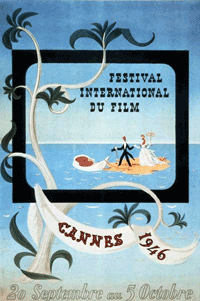 At the first Cannes Film Festival 11 films win the Grand Prix: Brief Encounter, The Great Turning Point, The Last Chance, The Lost Weekend, Men Without Wings, Neecha Nagar (Lowly City)the directorial dιbut of Chetan Anand (1915-1997) and the first Indian film to win a top prize at an international film festivalThe Prize, The Red Earth, Rome Open City and Symphonie Pastorale At the first Cannes Film Festival 11 films win the Grand Prix: Brief Encounter, The Great Turning Point, The Last Chance, The Lost Weekend, Men Without Wings, Neecha Nagar (Lowly City)the directorial dιbut of Chetan Anand (1915-1997) and the first Indian film to win a top prize at an international film festivalThe Prize, The Red Earth, Rome Open City and Symphonie Pastorale |
< 1939 |
| September 15 |
BBC televises its first religious service. |
|
| September 27 |
CBS presents a petition to the Federal Communications Commissions seeking adoption of its colour television standard. |
|
| September 27 |
The Federal Communications Commissions licenses the 1,000th AM radio station in the USA. |
|
| September 29 18:00 |
Start of BBC Third Programme, a cultural radio service. |
|
| October 20 |
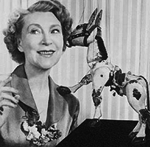 Wooden puppet Muffin the Mule makes its debut in BBC children's television programme For the Children, presented by Annette Mills. Wooden puppet Muffin the Mule makes its debut in BBC children's television programme For the Children, presented by Annette Mills. |
|
| October 24 |
BBC Third Programme broadcasts Wagner's opera Tristan and Isolde in full, conducted by Sir Thomas Beecham—a 5½-hour programme with intervals. |
|
| October 30 |
RCA gives the first public demonstration of its colour television developments. |
|
| November 1 |
In New York, radio station WABC becomes WCBS and WEAF changes its call sign to WNBC. |
|
| November 1 |
First Royal Film Performance is held in the presence of King George VI and Queen Elizabeth at the Empire, Leicester Square, London. The film selected is Michael Powell and Emeric Pressburger's A Matter of Life and Death (released as Stairway to Heaven in the USA). |
|
| November 4 |
RCA demonstrates all-electronic colour television using three picture tubes. |
|
| November 4 |
United Nations Educational, Scientific and Cultural Organisation (Unesco) is founded. |
|
| November 9/10 |
 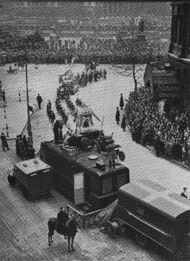 BBC televises the Lord Mayor's Show [left picture] and the Remembrance Service from the Cenotaph in Whitehall [right picture]. To allow a repeat transmission in the evening, the events are simultaneously recorded directly on film; the film camera can just be seen behind the television cameraman on the platform in Whitehall. BBC televises the Lord Mayor's Show [left picture] and the Remembrance Service from the Cenotaph in Whitehall [right picture]. To allow a repeat transmission in the evening, the events are simultaneously recorded directly on film; the film camera can just be seen behind the television cameraman on the platform in Whitehall.
Photos: BBC Yearbook 1947 |
|
| November 11 |
NBC recruits its first television advertiser, Bristol-Myers, for Geographically Speaking, which has been on air since 27 October. |
|
| November 26-December 10 |
First General Conference of United National Educational Scientific and Cultural Organisation (Unesco) in Paris. |
|
| December 21 |
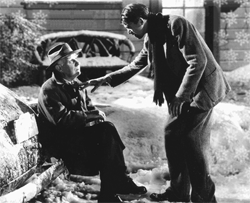 Frank Capra's It's a Wonderful Life, starring James Stewart and Donna Reed, is premiered at the Globe Theatre, New York, following a charity screening the previous day. During the production, artificial snow is created by a mixture of fire-fighting chemical foamite, soap and water, sprayed under high pressure into the air stream from a wind machine; 6,000 gallons are used during the production. (Previously, corn flakes painted white had been used for snow.) RKO's special effects department wins a special Academy Award for its invention; none of the film's five nominations wins an Oscar. Frank Capra's It's a Wonderful Life, starring James Stewart and Donna Reed, is premiered at the Globe Theatre, New York, following a charity screening the previous day. During the production, artificial snow is created by a mixture of fire-fighting chemical foamite, soap and water, sprayed under high pressure into the air stream from a wind machine; 6,000 gallons are used during the production. (Previously, corn flakes painted white had been used for snow.) RKO's special effects department wins a special Academy Award for its invention; none of the film's five nominations wins an Oscar. |
|
| December 24 |
WABD televises a church service for the first time from Grace Episcopal Church, New York via its stations in New York, Washington and Philadelphia. |
|
| |
Zoomar zoom lens, developed by Dr Frank Back for 16mm cameras, is the first to use only optics to achieve the zoom effect. It provides a focal length range of 17.5mm to 70mm. |
|
| |
First colour 3D talking picture, Robinson Crusoe, is made on the Black Sea coast, in the USSR, directed by A N Andreyevsky. |
|
| |
Warner Bros, already a shareholder, acquires a controlling interest in Associated British Picture Corporation (ABPC). In theory, Warner would now distribute ABPC films in its 800-screen US cinema chain, while ABPC would show Warner films in its UK cinemas. |
|
| |
US film industry earns $232m in domestic rentals and accounts for 1.5 per cent of total US corporate profit. |
|
| |
BRitish films gross $3.7m in the US, according to MPAA president Eric Johnston, who forecasts a $10m+ gross in 1947. |
|
| |
Sir Alexander Korda buys back the negatives of his film productions from Prudential Assurance, which had seized them with other assets to recover debts but did not regard film negatives as of great value. |
|
| |
Sir Alexander Korda buys a controlling interest in British Lion Film Corporation. |
|
| |
Erich Pommer by now an American citizen, is appointed Film Production Control Officer to rebuild the German film industry during denazification and reconstruction. |
|
| |
Alliance Film Studios is formed to control production facilities at Riverside and Twickenham; it acquires Southall Studios. |
|
| |
Group 3 film production company is formed at Southall Studios, west London, with John Grierson as executive producer. |
|
| |
 First Afghan film production is an Indian co-production: Ishq Wa Dosti (Love and Friendship), directed by Reshid Latif. First Afghan film production is an Indian co-production: Ishq Wa Dosti (Love and Friendship), directed by Reshid Latif. |
|
| |
Twenty-year-old Youth is the first Japanese film to include an on-screen kiss. |
|
| |
Arriflex 35 II reflex film camera is introduced by Arnold & Richter with a production batch of 70 cameras. By now 17,000 Arriflex 35mm cameras have been made. |
|
| |
Cinema audiences reach their all-time peak: 4,067m ($1,692m in ticket sales) in the US, 1,640m in the UK. |
|
| |
Of 447 films registered in the UK, 83 (18.5 per cent) are British. |
|
| |
There are now around 300 drive-in cinemas in the US. |
|
| |
First edition of the annual Film Review, edited by F Maurice Speed, is published in the UK. |
|
| |
Canadian Broadcasting Corporation opens FM radio stations in Montreal and Toronto. |
|
| |
British-based company Overseas Rediffusion starts commercial radio broadcasting in the West Indies. |
|
| |
House of Representatives Committee on Un-American Activities (HUAC) begins to investigate alleged Communist infiltration in Hollywood. |
Red menace in Hollywood |
| |
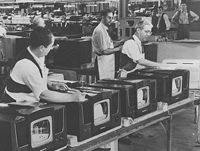  RCA introduces its first post-war television receiver, model 630-TS. It claims to have sold around 10,000 sets by the end of the year at a launch price of $435, later reduced to $385. Other sources estimate total sales of television sets in the US at 8,000 by the year end. The RCA receiver is sold under other companies' brands in their own cabinets. RCA introduces its first post-war television receiver, model 630-TS. It claims to have sold around 10,000 sets by the end of the year at a launch price of $435, later reduced to $385. Other sources estimate total sales of television sets in the US at 8,000 by the year end. The RCA receiver is sold under other companies' brands in their own cabinets. |
|
| |
Chevrolet division of General Motors becomes the first automobile advertiser on US network television. |
|
| |
Television service starts in USSR. |
Television service start dates |
| |
Civil estimate (budget) for broadcasting in the UK in the 1946/47 year is £7.5m, reduced from £9m in the previous year. |
|
| |
Zenith begins public tests of its Phonevision pay TV technology in the US. |
|
| |
First full-time Spanish-language radio station in the US is founded by Nathan Safir at KCOR, to which is later added a television service. |
|
| |
Television Arts and Sciences Academy is founded by Syd Cassyd. |
|
| |
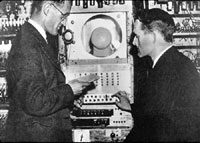 Professor (later Sir) F C (Freddie) Williams [left] and (later Professor) Tim Kilburn (1921-2001) [right] at the University of Manchester begin work on developing a programmable digital computer, known as Baby [centre], using cathode ray tubes to store data. By the year end they have manage to store one binary digit (bit). Professor (later Sir) F C (Freddie) Williams [left] and (later Professor) Tim Kilburn (1921-2001) [right] at the University of Manchester begin work on developing a programmable digital computer, known as Baby [centre], using cathode ray tubes to store data. By the year end they have manage to store one binary digit (bit). |
|
| |
Number of telephones in the UK reaches 4m during the year. New installations at a rate of 700,000 a year are anticipated. A private residence line costs £1-£1 6s (£1.15) per quarter, including 4s 2d (21p) of local calls. Charges are greater for installations more than 3 miles from the exchange. |
|
| |
Microfilm division of Pathι Manufacturing Company bought by Bell & Howell. |
|
| |
US restrictions on the importation and use of shellac are totally lifted, allowing a boom in record sales, which reach 247m—double the previous year’s level. |
Record industry < 1941 |
| |
Phonographic Performance Ltd establishes a fund to compensate British musicians for the loss of live engagements caused by the playing of records on the radio. |
|



















